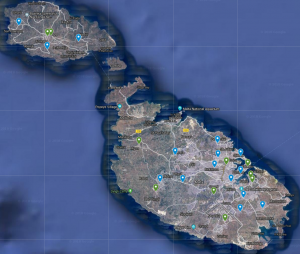Malta participates only to Phase 1 of this initiative.
I. Information about the chosen schools
1. Where is/are the school(s) located (name of city, urban/sub-urban/rural)?
The 25 schools chosen are spread throughout Malta and Gozo and are found in urban, sub-urban and rural areas.
2. What kind of school(s) has/have been chosen (nursery, primary, secondary etc.)?
Primary and Secondary schools have been chosen.
3. How far is/are the school(s) away from busy roads?
The distance from busy roads varies according to the location. Worst case scenario is ~90 m from a major arterial road.
4. What kind of buildings surround the school(s) (e.g. is it located in a street canyon)?
Since the majority of the schools chosen are in an urban area, the nature of the buildings surrounding these schools are mostly residential/offices. We are in the process of preparing an inventory which will specify such details.
5. Do you have information on the traffic volume and/or the kind of vehicles passing in front of the school and/or on the neighbouring streets? If yes, please provide this info.
Unfortunately, data on traffic volume and/or the kind of vehicles passing in front of the school and/or on the neighbouring streets is not currently available.
6. Please provide an electronic ‘snap shot’ map of the
- city or district where the school(s) is/are located, and of
- school’s/schools’ close surroundings.

7. Other information, which you would like to share about the schools?
Malta has 25 schools in total of which 14 are urban, 6 are sub-urban and 5 are rural. In 10 of these schools they have already carried out a 4-week monitoring period in summer, when no activities were being carried out at the schools.
II. Information about the measurement approach
1. What kind of passive samplers do you plan to use, or which ones have you already used to measure NO2? How many?
Passam diffusion tubes (NO2 passive samplers) have been chosen. 2 at the drop-off/pick-up point and another 2 at the school playground.
2. Do you plan to use or have already used sensors to measure PM? If yes, which ones? How many?
Sensors to measure PM will not be used.
3. Do you plan or have you already compared results of your measurement equipment with or calibrated against official measurement stations?
Malta has carried out an equivalence study over a 3-year period at traffic, urban background and background sites, i.e. has compared diffusion tube results with those of official measurements.
4. Where do you plan to locate or have already located the measurement devices? If possible, please indicate this on the map(s) mentioned under I.), or provide coordinates.
Measurement devices will be placed at the drop-off/pick-up point and another at the playgrounds of the schools shown in the map.
5. Please provide also info on the close surroundings of the measurement devices, e.g. in front of school (busy street, street canyon etc.), in the schoolyard, in the surroundings of the school(s).
Measurement devices will be placed in front of each school (i.e. the drop-off/pick-up point) and in the schoolyard.
6. Which sampling period(s), i.e. months have you chosen?
The main monitoring period will be 20th March – 17th April 2019. We are interested in a second exposure period before summer 2019.
7. Do you also plan to count vehicles, vehicle types?
Malta will explore acquiring data from traffic counts from those streets.
III. Communication with pupils, teachers, parents
Foster engagement: Communicating about the project
1. Please indicate if you have any communication material already available and, if yes, what kind of material they are, e.g. from previous initiatives that can be useful for other participants.
Malta is currently working on appropriate communication material.
2. Do you plan to cooperate with local administration responsible for air quality, traffic, urban planning etc.? If yes, which ones.
- In Malta’s case the project is being led by the EPA. They will be collaborating with the agency responsible for road transport by requesting traffic counts data.
- Malta is collaborating with the Ministry for Education for communicating with the schools and preparing relevant communication material.
3. Are there any civil society initiatives or communities that are active in that domain in your countries? Which ones? They might have some useful communication material and contacts.
No such initiatives have as yet been carried out in Malta.
Citizen science and behaviour change: capturing long-term impacts
4. How do you plan to ‘measure’ change in behaviour, see for example the before-after questionnaire used by ‘Curious Noses’?
This is still under discussion.
5. Some concrete questions have been suggested in relation to the citizen science approach:
- Can citizen science be used as a means of changing mobility behaviours in and around schools that influence air quality?
- What ways of citizen science can be employed to changing such behaviour?
- How effective are these ways of citizen science in changing mobility behaviour influencing air quality?
What kind of question(s) have you formulated?
They believe that the proposed questions are adequate and the original question they had formulated is very similar.